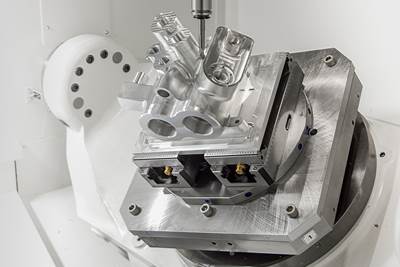Share



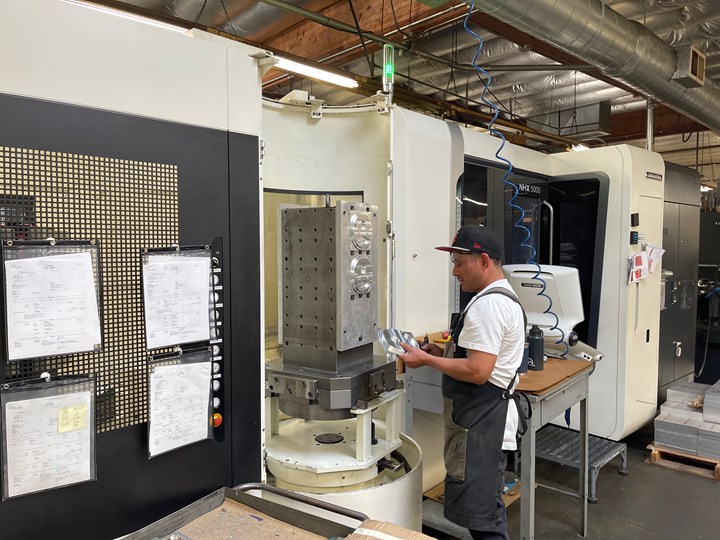
N.C. Engineering’s investments in five-axis machining and automation solutions have increased its capacity to make parts for its customers across a variety of industries.
When approaching the gate of N.C. Engineering, a Los Angeles-area precision manufacturer that serves the aerospace, satellite, semiconductor, medical, robotics and automotive industries, it has a rather inconspicuous look. It’s separated into two small buildings, one containing the office and machine shop, and the other a converted tortilla factory that houses the shop’s deburring and inspection areas.
What isn’t seen from a passing glance is the impressive array of machining centers inside, one that’s much larger than you’d typically find in a small, 20-person shop. The shop’s five-axis work is done on a couple of DMG Mori DMU-50s. It has a four-axis Mori Seiki DuraVertical 5100 and a four-axis Hyundai Wia, and for horizontal work, it runs two DMG Mori NHX5000s and a Kitamura Mycenter HX300iG. Its three-axis machines include a Mori Seiki DuraVertical 5080, two Hyundai Wia machines and three FADAL machining centers. The shop currently has one Brother Speedio S700Xd1 with plans to add more, and for inspection, N.C. Engineering relies on a Brown & Sharpe 7107 Global Performance CMM.
This fleet of machining technology didn’t appear overnight. The investment in this equipment came from a shift in mindset and an increase in demand from certain industries thanks to a recent push to manufacture more parts domestically.
Optimizing to Meet Demand
N.C. Engineering says it has seen a tenfold increase in demand for semiconductor parts due to a recent push to bring semiconductor manufacturing back to the U.S.
A few years ago, N.C. Engineering vice president Gerald Fazis and president Patrick Mason decided it was time to invest in technology that could optimize its processes and allow for more complex machining angles, as well as an option to run lights out. Initially, the two sought out another horizontal machining center, but one of N.C. Engineering’s sales reps from DMG Mori said they had a demo DMU 50 five-axis machine the shop could borrow until the horizontal was delivered. After running the demo machine for a while, Mason and Fazis decided to automate it with an Erowa Robot Compact 80 pallet system and buy the DMU 50 on top of the horizontal they had on order.

N.C. Engineering President Patrick Mason says this DMG Mori DMU 50 and Erowa Robot Compact 80 are key pieces of the shop’s success with five-axis machining and automation.
Now, the automated five-axis machining center is a staple of the shop’s work.
“This combination is our bread and butter,” Mason says. “It’s running almost 24 hours a day every single day.”
Automation was needed for N.C. Engineering to compete with prices overseas, so it runs one manned shift and keeps four of its 15 machines running through the night. The plan is to put together a skeleton crew for the second shift to maintain machines, be present in case there’s downtime from tool breakage or other factors and prep the machines to run through the night.
This setup has allowed N.C. Engineering to compete with low labor costs in China and gain more work from customers like Productive Robotics. The shop started machining the bases for Productive Robotics’ cobots after Productive Robotics began making a push to keep its supply chain domestic and receive fewer parts from overseas due to the supply chain issues brought on by COVID-19. N.C. Engineering also uses Productive Robotics’ cobots for machine tending, and its plan is to eventually bring in more cobots to fill a section of its shop with robot-tended machines.
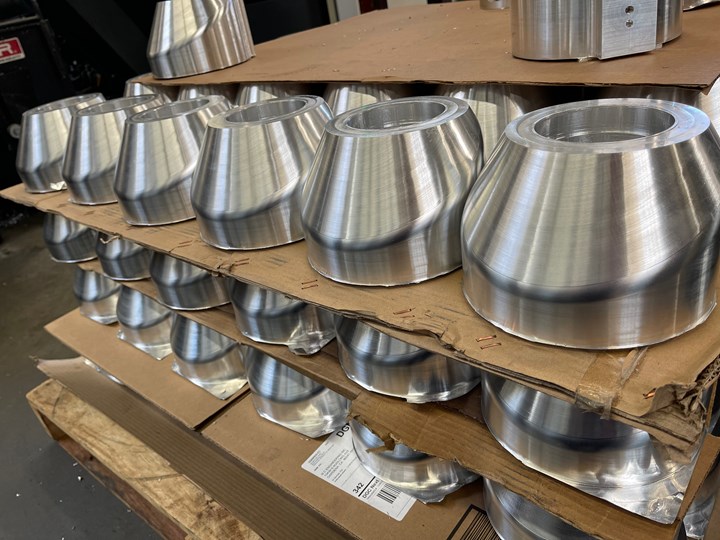
N.C. Engineering machines the bases for Productive Robotics’ cobots, shown on this pallet of completed parts.
“The way that we’ve been able to compete with China is the machinery and running lights out,” Fazis says. “That’s really the only way. They’ve got to buy the same machines. They’ve got to have the same property. Really, the biggest factor is labor. So, if we can run lights out, that saves us in labor.
“A lot of people think it’s going to take jobs away from people and there’s going to be fewer jobs for machinists, but as soon as we started to automate, we had to hire a lot more people because of our output.”
N.C. Engineering has hired more people to inspect and deburr parts, maintain machines, and run the shipping and receiving area. The shop says its staff has doubled to around 20 people since moving to lights-out production.
Finding Efficiency With Five-Axis
Machine shops working with medical, aerospace and semiconductor customers must often adhere to tight tolerances and complex designs. That’s the case for many of the parts produced at N.C. Engineering. With its tight tolerance requirements, the shop says machining one of its semiconductor parts solely on its three-axis machines was inefficient and limited the quantities it could produce prior to investing in five-axis machines. It made special fixturing to hold the part, and a machinist would spend almost an entire shift drilling just a hole and a counterbore for the part.
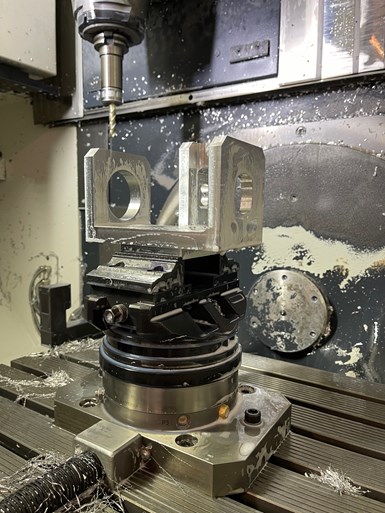
Investing in five-axis machining allowed N.C. Engineering to make this semiconductor part more efficiently and meet an increase in demand.
With its investments in five-axis machining centers and automation solutions, the shop now uses three different mills to machine the part. It starts on a horizontal machine to prep the part for a holding tab, then moves to the automated five-axis that can hit all the complex angles to machine the part complete and engrave it. After it lands in a vertical mill to remove the milling tabs used to hold the part, it is moved to a CMM to check its tolerances and surfaces. This change in the process has allowed N.C. Engineering to go from machining about 20 of these parts per month solely on three-axis machines to around 200 parts monthly.
“We can see the giant increase in parts, and the only way to keep up with those numbers with the size that we are — we’re not a giant shop — was to automate and run through an essential second shift,” Fazis says.
Invest to Progress
The investments in five-axis machining and automation solutions at N.C. Engineering came from a change in mindset that started within the past few years. When Fazis’ father founded the shop in the 1970s after starting his career at a watch factory in his home country of Germany, he kept the shop debt-free as often as possible and would pay for new machines with cash or small, conservative loans. That philosophy carried over when Fazis and Mason, Fazis’ brother-in-law, took ownership of the shop in the late 1990s when Fazis’ dad retired.
“When we started to make improvements, Gerald and I would be like, OK, we can afford a loan, so we’ll do it and we’d have like, one machine payment. God forbid if we had two,” Mason said. “We were very conservative about that. (Beginning to invest) was huge for us. Luckily we’ve been able to maintain the level of business to support it all, but that was a huge diversion in how we did things, going from an $80,000 vertical mill to a half-a-million dollar five-axis.”
To take that big of a jump, the return on investment had to justify the move. Pairing the Erowa and five-axis machining center adds up to around a $600,000 investment, but the increased capacity for production — the unmanned 12-hour shift the shop can now run daily — has increased the shop’s efficiency and throughput enough to justify the decision from a business perspective.

Since investing in five-axis machines and automation solutions, N.C. Engineering says it has had to hire more people to maintain machines, inspect parts and deburr.
Going in Green to Machine
Fazis and Mason didn’t expect to take over the shop and start running the business when they did. Aside from Fazis running a chop saw as a kid when his dad brought him to the shop, he had no prior machining experience. He attended junior college for two years and had planned to transfer to a university, but when he visited his counselor to explore transfer options, he was told he actually had another year left.
“And then from there, that was my last official semester,” he says.
Fazis quickly pivoted and got a job at N.C. Engineering, working full-time for his dad while taking night classes on machining, programming and economics, hoping he’d learn what he needed to run a business.
Mason also attended El Camino Community College and transferred to California State University. He joined the Marines, and his original plan after leaving the military was to fly helicopters for law enforcement or fire rescue teams. While Mason was in college, he needed a part-time job, so his then-girlfriend (now wife) suggested asking her dad if he had any work available at his company.
“I had zero idea what her dad does,” Mason says. “I was in my early 20s and I had zero idea that machine shops even existed. But I grew up working with my hands with my dad and cars and things like that, so it was interesting to me.”
Mason’s work was good enough that it led to a full-time job. Fazis began working for the shop around 1996, and his dad retired a couple of years later, leaving Fazis and Mason in charge of the shop just a few years after joining the company. Fazis’ dad stayed around to make sure things were going OK with the transition, but his role lessened as the two became comfortable in their new positions.
“He invested a lot of blood, sweat and tears into this place, and it behooves him to make sure it was going the way he thought it should,” Mason says.
Today, Fazis and Mason have some big decisions on the horizon in regard to where to take the business. They’d like to expand and add a few more machines to the shop floor, but they’re close to maxed out with their floor space, meaning their only options are to buy a new property — a hefty check to write in California — or to build vertically, putting the office on a potential second floor and adding machining space where the office currently sits.
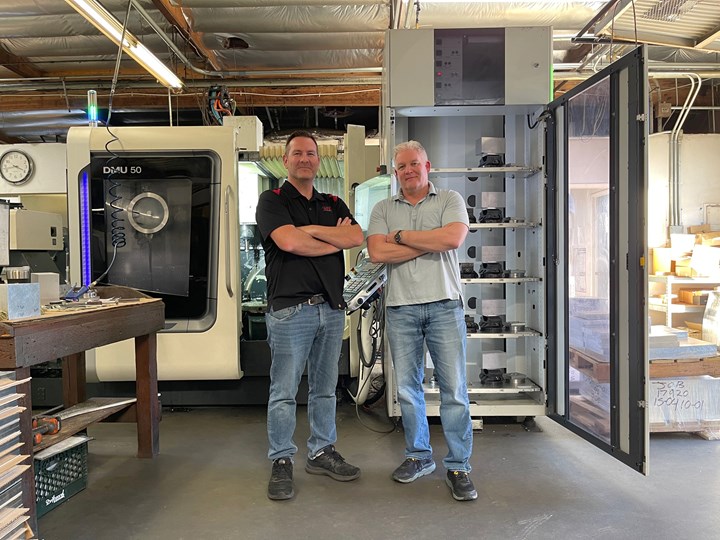
Gerald Fazis, left, and Patrick Mason, right, have served as vice president and president, respectively, of N.C. Engineering since Gerald’s father, the company’s founder, retired in the late 1990s.
The other — and perhaps more consequential — decision, is succession planning. Mason is 52 years old and doesn’t plan to stick around when he’s past 60, while Fazis is 46. Mason’s daughters and wife run a preschool, so they already have their own business to tend to. Fazis has a son and a daughter, both teenagers, who could step in and eventually run the company if they choose to do so. Fazis doesn’t want to put pressure on them to follow his path, but he has opened it up as an option.
“My preference — and Gerald knows this — I would love for one of his kids, probably his son, to come in and have this be a third-generation company,” Mason says. “It would be awesome for his dad, for Gerald and for his son. I would love to see it from the outside, prospering and continuing.”
While Fazis likes that idea, he thinks back to when he was a teenager who didn’t know what his path in life would be and wants his kids to come to their own decision. Still, he has them come work in the shop during the summer to get familiar with how the business works.
“I didn’t know that I wanted to work here, and same with Pat when he was 20; he didn’t know that he wanted to work here, so I would never put that on my kids,” Fazis says. “What I did tell them is, just be familiar with the business. If that day does come, I want you to have a better jumpstart at running the business than what I had. We kind of got thrown into it, so I just want them to be familiar with what we do here.”
Related Content
Aerospace Shop Thrives with Five-Axis, AI and a New ERP
Within three years, MSP Manufacturing has grown from only having three-axis mills to being five-axis capable with cobots, AI-powered programming and an overhauled ERP. What kind of benefits do these capabilities bring? Find out in our coverage of MSP Manufacturing.
Read MoreOrthopedic Event Discusses Manufacturing Strategies
At the seminar, representatives from multiple companies discussed strategies for making orthopedic devices accurately and efficiently.
Read MoreThe Power of Practical Demonstrations and Projects
Practical work has served Bridgerland Technical College both in preparing its current students for manufacturing jobs and in appealing to new generations of potential machinists.
Read MoreHow to Successfully Adopt Five-Axis Machining
While there are many changes to adopt when moving to five-axis, they all compliment the overall goal of better parts through less operations.
Read MoreRead Next
10 Ways to Think Differently about Robotic Automation
Take another look: A lot is happening in and around robotic automation. What robots might mean for machining and manufacturing is getting ready to change.
Read MoreFive Traits Define Top Performers in Five-Axis Machining
Benchmarking data reveal how elite manufacturers make the most of more axes of motion.
Read MoreChoosing a Five-Axis Machine Tool With Automation in Mind
While much focus is placed on the machinery that moves parts, the features most important for automating five-axis machining are arguably found in the machine tool itself.
Read More


























